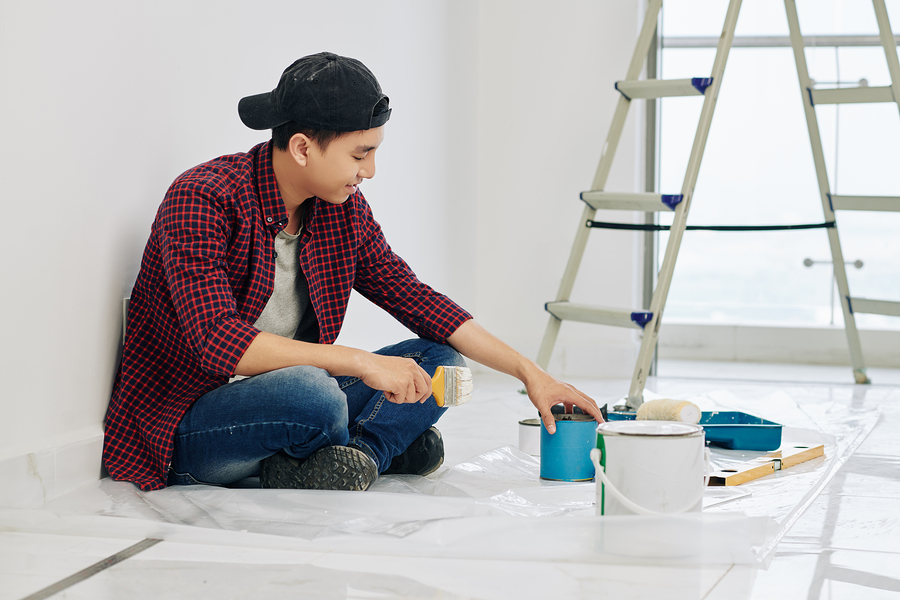Have you noticed your ceiling or walls aren’t looking as smooth as they once were? Bubbling and peeling paint can be unsightly, and as a homeowner, it’s a problem you can’t ignore. It’s important to understand why paint bubbles and peels, as it can help prevent further damage and maintain the aesthetic appeal of your home.
In the following sections, we’ll explore the common causes of paint bubbling and peeling, how to evaluate the severity of the issue, and steps to repair and prevent future occurrences. Whether you’re a DIY enthusiast or considering professional help, this guide is for you.

Identifying the Causes of Bubbling and Peeling Paint
Paint bubbling occurs when the paint film lifts from the underlying surface, forming blisters or bubbles. This often leads to wall peeling, where sections of paint come away from the wall. It’s not only an eyesore but also an indication of underlying problems that need addressing.
One of the primary reasons for paint bubbling and wall peeling is moisture. Humidity or leaks can seep into walls, causing the paint to lose its adhesion. This is especially common in bathrooms, kitchens, and basements where moisture levels are higher. Inspecting for leaks or condensation is vital to prevent further paint damage.
Another culprit could be poor surface preparation before painting. If the walls weren’t properly cleaned, sanded, or primed, the paint might not adhere correctly, leading to bubbles. Dirt, grease, and previous paint layers can create a barrier that prevents new paint from sticking as it should.
Low-quality paint or incorrect application techniques can also lead to issues. Cheaper paints might lack the necessary components for proper adhesion and flexibility, making them more prone to bubbling. Additionally, applying paint in unsuitable conditions, such as high humidity or extreme temperatures, can contribute to the problem.
Evaluating the Extent of Damage
Before jumping into solutions, it’s crucial to assess the extent of the damage. Minor bubbling may only affect small areas and can often be remedied with minimal effort. A quick inspection and some touch-up work might suffice, saving time and resources.
However, if you notice extensive wall peeling or large paint bubbles, this could indicate a more serious problem. Major issues might suggest significant moisture infiltration or structural concerns that need addressing before repainting can occur. Ignoring these signs can lead to further deterioration and costly repairs down the line.
Examine the affected areas closely. A small patch of bubbling localized to a single area might be an isolated incident. However, if multiple walls or the entire ceiling are affected, it might be time to consider more comprehensive measures, potentially enlisting the help of a professional.
Repairing Paint and Wall Damage
Once you’ve evaluated the damage, it’s time to start repairing. Begin by removing the old, damaged paint. Use a scraper to gently peel away the loose sections without damaging the underlying surface. Patience is key here—removing the paint carefully will prevent further surface damage.
Next, address any cracks or holes that have surfaced. Fill them with a suitable filler or spackle, smoothing them out to create a seamless finish. Allow the filler to dry completely before moving on to the next step. This process ensures the surface is even and ready for repainting.
Sanding is an essential step in ensuring a smooth finish. Use fine-grit sandpaper to gently sand the filled areas and the surface around them. This helps create a texture that the new paint will adhere to, minimizing the risk of future bubbles and peeling. Remember to clean the surface thoroughly after sanding to remove any dust and debris.
Preventing Future Paint Issues
Prevention is better than cure. To avoid future paint issues, improving ventilation in your home is crucial. Ensure adequate airflow in areas prone to humidity, such as bathrooms and kitchens. Installing exhaust fans or dehumidifiers can help regulate moisture levels and protect your walls.
Choosing the right paint is also a critical step. Opt for high-quality paints designed for specific environments. For example, use moisture-resistant paint in bathrooms and kitchens. This type of paint is formulated to withstand higher humidity levels, reducing the risk of bubbling and peeling over time.
Sealing surfaces before painting can enhance paint adhesion. Applying a primer suitable for your wall type creates a barrier that prevents moisture infiltration and promotes a smoother finish. Primers are especially beneficial for surfaces that have undergone significant repairs or are being painted for the first time.
DIY vs Professional Drywall Repair
Deciding whether to tackle the issue yourself or hire a professional depends on several factors. Minor bubbling and peeling that affects only a small area can be a manageable DIY project. With the right tools and guidance, you can restore your walls to their former glory.
However, if the problem is extensive, or if you suspect underlying structural or moisture issues, consulting a professional is advisable. Experts in drywall repair and drywall finishing have the skills and knowledge to address complex problems effectively, ensuring a long-lasting solution.
Weigh the pros and cons of each approach. DIY projects can be cost-effective and satisfying, but they require time, patience, and a willingness to learn. Professional services, while more costly upfront, offer peace of mind and expertise, particularly for significant or complicated repairs.
Cost Considerations and Budgeting Tips
Understanding the costs associated with paint repair and prevention is essential for budgeting. DIY repairs typically involve purchasing materials such as paint, primer, filler, sandpaper, and tools. While these costs are generally lower, the time investment should also be considered, especially for larger projects.
Hiring a professional comes with higher initial costs but offers the benefit of expert solutions and faster turnaround times. Professionals can provide accurate assessments, comprehensive repairs, and high-quality finishes, often saving money in the long run by preventing repeated issues.
Consider obtaining multiple quotes from reputable contractors to compare prices and services. This will help you make an informed decision that aligns with your budget and the severity of the issue. Don’t forget to account for any additional improvements, like installing ventilation, that can prevent future problems and protect your investment.
Final Thoughts
Dealing with bubbling and peeling paint is a common challenge for homeowners, but it’s one that can be effectively managed with the right approach. Understanding the causes, evaluating the damage, and implementing tailored solutions are key steps in restoring your walls and ceilings.
Remember, timely intervention and regular maintenance not only enhance the appearance of your home but also protect your investment. By addressing issues as they arise and taking preventive measures, you can enjoy a durable and attractive paint job for years to come.
Should you require further assistance or wish to explore professional services, consider reaching out to a reputable drywall repair company. They can offer valuable advice and expertise tailored to your specific needs.
Are you tired of looking at your wall and ceiling damage? Let us revamp your space at a price you can afford. Contact Drywall by Renso at 317-269-7319 for professional drywall services in Indianapolis, Indiana. We serve residential and commercial clients.
Related Posts:
Professional Painting Guide for New Sheetrock Walls
How to Prime Your Walls Before Painting Them
Apply These Painting Tricks to Paint Like a Professional



